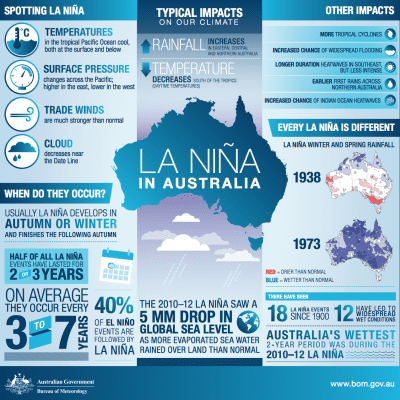CLIMATE models and observations suggest the 2021–22 La Niña has peaked, and will most likely return to neutral El Niño–Southern Oscillation (ENSO) – neither La Niña nor El Niño – during the southern hemisphere autumn.
La Niña increases the chance of tropical cyclones and above average rainfall across northern and eastern Australia during summer and to a lesser degree, autumn. As La Niña weakens it can continue to influence global weather and climate.
Atmospheric and oceanic indicators remain at La Niña levels, but have likely peaked in strength.
While eastern tropical Pacific sea surface temperatures remain cooler than average, beneath the surface, waters in the central and eastern Pacific are now warming. These changes in the sub-surface typically foreshadow a breakdown in a La Niña event, which normally occurs in the southern autumn. In the atmosphere, decreased cloudiness along the Date Line, strengthened trade winds in the western Pacific and a positive Southern Oscillation Index (SOI) reflect a mature La Niña.
The Madden–Julian Oscillation (MJO) has strengthened over the eastern Indian Ocean in recent days. Most climate models suggest the MJO is likely to progress eastwards into the Maritime Continent in the coming week at moderate strength. Typically, when the MJO is in the Maritime Continent, enhanced cloudiness and rainfall occurs over northern Australia, and also across tropical regions to Australia’s north.
The Southern Annular Mode (SAM) is neutral, and is forecast to remain neutral over the coming three weeks. A neutral SAM has little influence on Australian climate.
The Indian Ocean Dipole (IOD) is neutral. It typically has little influence on global climate from December to April due to the influence of the monsoon.
Climate change continues to influence Australian and global climate. Australia’s climate has warmed by around 1.47 °C for the 1910–2020 period. Rainfall across northern Australia during its wet season (October–April) has increased since the late 1990s. In recent decades there has been a trend towards a greater proportion of rainfall from high intensity short duration rainfall events, especially across northern Australia.
Source: Bureau of Meteorology

